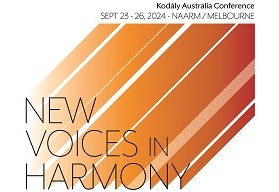Celia Dodds
In my recent experience, when I ask friends and colleagues the question “How is your Prep (or Year 1) child going?”, all too often they answer “tired”, “exhausted” and “busy”. Prep and school life is regularly talked about as being “full-on”, “hectic” and “jam-packed”. Of course, a great many of our little people are thoroughly enjoying their early childhood programmes, but on a personal level, I have some concerns about the direction of our early childhood philosophies in the school setting. I wondered if the role of the specialist Music Teacher was contributing to this? A 30 minute lesson, squashed into an already busy day, led by an adult other than the classroom teacher, who more than likely struggled to know their names. More often than not, the classroom teacher who was the ‘constant’ in the children’s lives, left the room. Some children seemed oblivious to this, but clearly for some, this situation was a little confronting.
This article in no way purports to be a research paper, rather it is a discussion of how I have personally addressed an area of my teaching that I feel demands my attention.
As a general classroom teacher of many years, I very much felt that I could realistically create a classroom environment where children felt welcome, secure, nurtured and stimulated. The positive relationships that I could develop with my students were given time and priority in the way I planned the school day. Some time each morning was set aside for the children to talk with me and each other about events in their lives. Quiet, peaceful times were deliberately scheduled into the day and the afternoon pick-up gave me a chance to chat informally with parents about important things in the lives of the children in my care. If I sensed my children were becoming over-loaded and hurried, I could make the choice to alter the day’s programme to address the problem.
So then, how could I work to create a similar environment and nurture quality relationships in ½ hour a week with my Music classes?
Right from the start I sought to ‘set a welcoming tone’ for my lessons by smiling warmly at the start, using a quiet and gentle voice, taking the time to greet the children by using my ‘Hello’ song and encouraging them to take the time to greet each other. Part of this welcome involved the simple act of looking around at each other’s faces (something which I believe needs to be consciously taught to some children). Also, at appropriate times within a song or little dance, the use of a gentle touch (handshake, light touch on shoulder etc.). This helped the children to attend to each other through gesture, eye contact and song, and did much to assist in the creation of a room where the children feel emotionally connected.
In an effort to establish a more personal connection with the children in my classes, just as I did in the general classroom, from time to time I took a few moments at the start of each lesson to hear a little about the children’s lives.
I searched through my song materials to find songs that used children’s names – just another little way to become more connected with them and to make them feel valued and important. I am yet to meet a child who does not wish to feel special in the eyes of a teacher. Something as small as using a child’s name in a song or ensuring that a child is offered the opportunity to take a turn during a song or game can have a most profound effect.
And what about the classroom climate and my efforts to present 30 somewhat different minutes in the often-times hurried school day? A slower and more measured delivery of my ‘teacher talk’, the use of puppets to captivate the children’s imagination, contact with soft toys (for emotional connection, beat keeping, tickles and motivation), gentle finger plays, guided listening and lullabies all served to help reach my goal.
It would be unfair of me to suggest that I was successful in all I aimed to achieve in every lesson. Having said that, I can genuinely say that on a personal level, I felt that I had begun what I know to be an on-going process of transforming my teaching. I am lucky that so much of what I have learned in a Kodaly-based teaching methodology supported rather than contradicted what I knew in my heart to be the best for those special little people, my students.
The words of Maria Montessori continue to ring so true for me:
A positive learning climate in a school for young children is a composite of many things. It is an attitude that respects children. It is a place where children receive guidance and encouragement from the responsible adults around them. It is an environment where children can experiment and try out new ideas without fear of failure. It is an atmosphere that builds children’s self-confidence so they dare to take risks. It is an environment that nurtures a love of learning.
———-
 Celia has been a primary classroom teacher since 1989 and always had a keen interest in music and Music Education. For many years, she assisted with the choirs at her school (both conducting and accompanying). After an introduction to the Kodaly-based approach in her pre-service training, Celia undertook further studies in Kodaly- based Music Education. In order to deepen her understanding of students with special needs, Celia completed a Master of Education in this area. Celia is currently working part-time, teaching 16 classes from Prep-Year 3 as well as conducting a Senior Choral group. She thoroughly enjoys sharing her love of music-making with little people.
Celia has been a primary classroom teacher since 1989 and always had a keen interest in music and Music Education. For many years, she assisted with the choirs at her school (both conducting and accompanying). After an introduction to the Kodaly-based approach in her pre-service training, Celia undertook further studies in Kodaly- based Music Education. In order to deepen her understanding of students with special needs, Celia completed a Master of Education in this area. Celia is currently working part-time, teaching 16 classes from Prep-Year 3 as well as conducting a Senior Choral group. She thoroughly enjoys sharing her love of music-making with little people.



